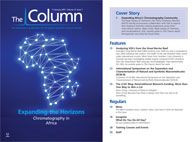Highlights from the 2016 Archives
Selected highlights from The Columns 2016 archives.
1. Split Injection GC: Inlet Liner Choice for Shoot and Dilute GC
Jack Cochran’s “Practical GC” provided readers with practical advice and new experimental evidence for how to get the best results from their gas chromatography (GC) systems. This instalment looked at GC inlet liner choice for “shoot and dilute” GC.
2. Onshoring Your Insourced Solutions?
Incognito debated the pros and cons of onshore support.
Raquel Garcia and Maria João Cabrita revealed the theory and practical applications of molecularly imprinted polymers (MIPs).
4. Detecting Carcinogens in Water
Koji Kosaka of the National Institute of Public Health, Japan, spoke with The Column about his use of high performance liquid chromatography (HPLC) to uncover the source of contamination in the Yodo River Basin in Japan, with the precursors of the carcinogen N-Nitrosodimethylamine (NDMA).
Protein biopharmaceuticals have seen an enormous growth in the last decade, and as a result, separation scientists are giving increased attention to methods for characterizing biopharmaceuticals. One powerful technique for analyzing proteins is two-dimensional liquid chromatography (2D LC). Gerd Vanhoenacker of the Research Institute for Chromatography (RIC) in Kortrijk, Belgium, spoke to The Column about his research into peptide mapping of therapeutic monoclonal antibodies (mAbs) using 2D LC.
Jean-Luc Veuthey and Alexandre GrandâGuillaume-Perrenoud revealed the latest developments in supercritical fluid chromatography (SFC) that are bringing the technique back to the limelight.
7. FPLC versus Analytical HPLC: Two Methods, One Origin, Many Differences
This article discussed the differences between the two techniques with particular emphasis on the requirements of their respective analytes.
8. Contemporary Trends in Ion Chromatography
Ion chromatography coupled to mass spectrometry (IC-MS) does not follow the same rules as coupling other modes of liquid chromatography to mass spectrometry (LC–MS). Leon Barron from the Analytical & Environmental Science Division, at King’s College London, UK, revealed some of the misconceptions surrounding IC and discussed contemporary trends and novel applications for this inventive technique.
9. The Value of Chemometrics and Experimental Design to Analytical Chemists
Kevin A. Schug considered what the study of chemometrics and experimental design statistics can add to an analytical chemist’s work.
10. System and Column Volumes in HPLC: We Still Haven’t Gotten the Message
What is required to produce a highly efficient modern high performance liquid chromatography (HPLC) system/column combination? This instalment of the LCGC Blog explained more.

Understanding FDA Recommendations for N-Nitrosamine Impurity Levels
April 17th 2025We spoke with Josh Hoerner, general manager of Purisys, which specializes in a small volume custom synthesis and specialized controlled substance manufacturing, to gain his perspective on FDA’s recommendations for acceptable intake limits for N-nitrosamine impurities.
University of Rouen-Normandy Scientists Explore Eco-Friendly Sampling Approach for GC-HRMS
April 17th 2025Root exudates—substances secreted by living plant roots—are challenging to sample, as they are typically extracted using artificial devices and can vary widely in both quantity and composition across plant species.
Determining the Serum Proteomic Profile in Migraine Patients with LC–MS
April 17th 2025Researchers used liquid chromatography–mass spectrometry (LC–MS) in their proteomic analysis to compare the serum proteome of migraine patients with healthy controls and to identify differentially expressed proteins as potential migraine biomarkers.










